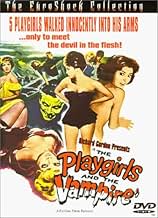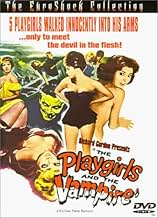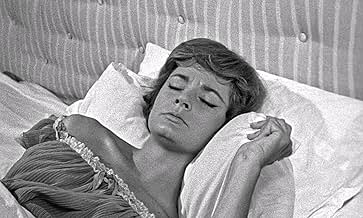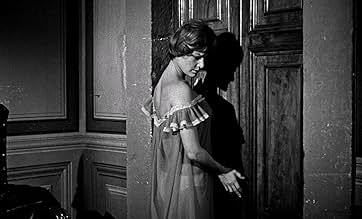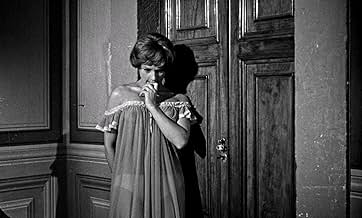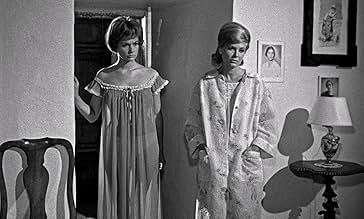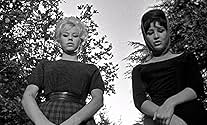CALIFICACIÓN DE IMDb
5.1/10
653
TU CALIFICACIÓN
Agrega una trama en tu idiomaFive beautiful showgirls are trapped by a storm and find refuge in a creepy old castle. The owner of the castle, a strange nobleman, has a secret laboratory in the basement and has his own p... Leer todoFive beautiful showgirls are trapped by a storm and find refuge in a creepy old castle. The owner of the castle, a strange nobleman, has a secret laboratory in the basement and has his own plans for the girls.Five beautiful showgirls are trapped by a storm and find refuge in a creepy old castle. The owner of the castle, a strange nobleman, has a secret laboratory in the basement and has his own plans for the girls.
Argumento
¿Sabías que…?
- TriviaMaria Giovannini's Katia is the first depiction of a nude vampire on screen; years before erotic/horror directors Jean Rollin and Jess Franco, and Hammer Studios made seductive naked women with fangs a staple of the genre.
- ConexionesEdited into FrightMare Theater: Playgirls and the Vampire (2017)
Opinión destacada
Ragnoli's film focuses on the travails of a group of five dance hall girls and their manager who, after defaulting on a hotel bill, find themselves bumping through unfamiliar countryside at night looking for late accommodation. Ignoring the warnings of a local, they continue along a side road to the castle of a mysterious Count Kernassy (Walter Brandi), where one of the girls, Vera experiences strong feelings of déjà vu. At first treated with coldness, it soon appears that the beautiful-yet-mopey Vera bears a startling resemblance to one of Count Kernassy's ancestors, Margherita. Ominously, the Count has an infatuation with this long-dead beauty. As sudden storms wash out bridges behind them, the troupe are obliged to spend more than one night at the castle and, despite warnings, venture out of the their rooms at night...
A minor camp item with some historical interest today, The Playgirls And The Vampire first saw light of day on the continent as L'ultima preda del vampiro (trans: The Vampire's Final Prey), an Italian attempt to capitalise on the vogue for the contemporary Hammer product with a suitably spiced-up Euro version. Adding lashings of female titillation in a way which was unthinkable to the Anglo Saxon market (the film includes a brief topless shot), director Piero Ragnoli made up a package which was both more lascivious than that produced by the studio at Bray, and one to which critical opinion has been less kind. Predictably, the heady cocktail was a commercial success at the time, and some commentators have since seen the results as anticipating the sexy vampire cinema of Jean Rollin a few years later, although the sheen of erotic sophistication brought by the French auteur is conspicuously missing here. American producer Richard Gordon, sensing money from the exploitation market, promptly picked up the English language rights to the original film, did a rush-dubbing job and re-titled it with an eye on maximum marquee appeal. (He also prepared a cut print for those areas in which censorship was more squeamish, under the title of Curse Of The Vampire - a version that by all accounts approached the incoherent).
While the beginning of this version of the film, which features a long tracking shot from a dungeon window to a stone sarcophagus and an emerging, spidery hand, momentarily recalls some of the splendours of such films as Bava's Mask Of The Demon (aka: La Maschera del demonio, 1960), such atmospherics are rarely repeated. The most effective moment occurs during the big burial scene later, where Aldo Greci's camera performs a 360-degree pan around the faces of the mourners from a low angle. Here the combination of a daring, continuous shot, allied with the distortions of a wide-angle lens produces the sense of dread a film like this so badly needs. Elsewhere the cinematography is more careless, with at least one scene suffering from a distracting focus problem, and the sparse interiors of the Count's castle being lit without subtlety. Unfortunately, the plot hardly distracts one from such shortcomings. Containing more holes than a ghoul's winding sheet, in execution it only emphases that for the most part Ragnoli's technical competence is mediocre. Given the electric possibilities which exist when sex and horror are combined, his film rarely aspires to the erotic, even though the glamorous playgirls are frequently to be seen wandering through chilly grounds and corridors, clad in nothing but their nighties.
What makes the film enjoyable is the passing campness of it all, the ineptness of the characters and the ludicrousness of some of the dialogue. The girls form part of a truly terrible dance troupe: when, after a tragedy, they gather to lose themselves in a rehearsal ("the girls have been very upset, and this is the only way to make them stop worrying about it" we are assured) and one performs a striptease, their lack of professionalism and poise in ensemble is laughable. Their manager, Lucas, (Alfredo Rizzo) is a crabby, cynical showman who is at least a more believable stereotype than the dull vampire fodder he escorts. In one of the more amusing moments of the film, we see him snuggling down in his room with a girlie magazine before being confronted by a nude, newly dead girl. Here his mugging is entertaining and the often self-conscious dialogue, which is a feature of the film, doesn't intrude. Elsewhere the non-sequiturs can be amazing ("I just don't understand it"/ "What don't you understand?"/ "Nothing, nothing at all" is one worthy of Ed Wood). As various mysterious events unfold, such conversations contribute to an atmosphere that can be just as bewildering to the audience as to the principals. Supporting characters, such as the groundskeeper, the limping Zoltan (probably Antoine Nicos), and the housekeeper (Marisa Quattrini) remain woefully undeveloped which given the nature of the genre, where every servant is a satanic stooge it seems, is surprising. One especially regrets the waste of the housekeeper. A demonic Mrs Danvers would have been a useful bonus in taking up some of the dramatic slack.
As "one of the first horror films from any country to mix Gothic horror and explicit eroticism," the film is a slight genre landmark. Perhaps a director with a greater sense of visual style would have made more of the opportunity, but the result is still watchable, if a little slow. For those who enjoy continental horror from this time - the start of a classic production period, which until recently has been hard to see - this is worth seeking out, if not essential viewing.
A minor camp item with some historical interest today, The Playgirls And The Vampire first saw light of day on the continent as L'ultima preda del vampiro (trans: The Vampire's Final Prey), an Italian attempt to capitalise on the vogue for the contemporary Hammer product with a suitably spiced-up Euro version. Adding lashings of female titillation in a way which was unthinkable to the Anglo Saxon market (the film includes a brief topless shot), director Piero Ragnoli made up a package which was both more lascivious than that produced by the studio at Bray, and one to which critical opinion has been less kind. Predictably, the heady cocktail was a commercial success at the time, and some commentators have since seen the results as anticipating the sexy vampire cinema of Jean Rollin a few years later, although the sheen of erotic sophistication brought by the French auteur is conspicuously missing here. American producer Richard Gordon, sensing money from the exploitation market, promptly picked up the English language rights to the original film, did a rush-dubbing job and re-titled it with an eye on maximum marquee appeal. (He also prepared a cut print for those areas in which censorship was more squeamish, under the title of Curse Of The Vampire - a version that by all accounts approached the incoherent).
While the beginning of this version of the film, which features a long tracking shot from a dungeon window to a stone sarcophagus and an emerging, spidery hand, momentarily recalls some of the splendours of such films as Bava's Mask Of The Demon (aka: La Maschera del demonio, 1960), such atmospherics are rarely repeated. The most effective moment occurs during the big burial scene later, where Aldo Greci's camera performs a 360-degree pan around the faces of the mourners from a low angle. Here the combination of a daring, continuous shot, allied with the distortions of a wide-angle lens produces the sense of dread a film like this so badly needs. Elsewhere the cinematography is more careless, with at least one scene suffering from a distracting focus problem, and the sparse interiors of the Count's castle being lit without subtlety. Unfortunately, the plot hardly distracts one from such shortcomings. Containing more holes than a ghoul's winding sheet, in execution it only emphases that for the most part Ragnoli's technical competence is mediocre. Given the electric possibilities which exist when sex and horror are combined, his film rarely aspires to the erotic, even though the glamorous playgirls are frequently to be seen wandering through chilly grounds and corridors, clad in nothing but their nighties.
What makes the film enjoyable is the passing campness of it all, the ineptness of the characters and the ludicrousness of some of the dialogue. The girls form part of a truly terrible dance troupe: when, after a tragedy, they gather to lose themselves in a rehearsal ("the girls have been very upset, and this is the only way to make them stop worrying about it" we are assured) and one performs a striptease, their lack of professionalism and poise in ensemble is laughable. Their manager, Lucas, (Alfredo Rizzo) is a crabby, cynical showman who is at least a more believable stereotype than the dull vampire fodder he escorts. In one of the more amusing moments of the film, we see him snuggling down in his room with a girlie magazine before being confronted by a nude, newly dead girl. Here his mugging is entertaining and the often self-conscious dialogue, which is a feature of the film, doesn't intrude. Elsewhere the non-sequiturs can be amazing ("I just don't understand it"/ "What don't you understand?"/ "Nothing, nothing at all" is one worthy of Ed Wood). As various mysterious events unfold, such conversations contribute to an atmosphere that can be just as bewildering to the audience as to the principals. Supporting characters, such as the groundskeeper, the limping Zoltan (probably Antoine Nicos), and the housekeeper (Marisa Quattrini) remain woefully undeveloped which given the nature of the genre, where every servant is a satanic stooge it seems, is surprising. One especially regrets the waste of the housekeeper. A demonic Mrs Danvers would have been a useful bonus in taking up some of the dramatic slack.
As "one of the first horror films from any country to mix Gothic horror and explicit eroticism," the film is a slight genre landmark. Perhaps a director with a greater sense of visual style would have made more of the opportunity, but the result is still watchable, if a little slow. For those who enjoy continental horror from this time - the start of a classic production period, which until recently has been hard to see - this is worth seeking out, if not essential viewing.
- FilmFlaneur
- 2 nov 2003
- Enlace permanente
Selecciones populares
Inicia sesión para calificar y agrega a la lista de videos para obtener recomendaciones personalizadas
- How long is The Playgirls and the Vampire?Con tecnología de Alexa
Detalles
- Fecha de lanzamiento
- País de origen
- Idioma
- También se conoce como
- The Playgirls and the Vampire
- Locaciones de filmación
- Productora
- Ver más créditos de la compañía en IMDbPro
- Tiempo de ejecución1 hora 23 minutos
- Color
- Mezcla de sonido
- Relación de aspecto
- 1.37 : 1
Contribuir a esta página
Sugiere una edición o agrega el contenido que falta

Principales brechas de datos
What is the French language plot outline for La última presa del vampiro (1960)?
Responda
